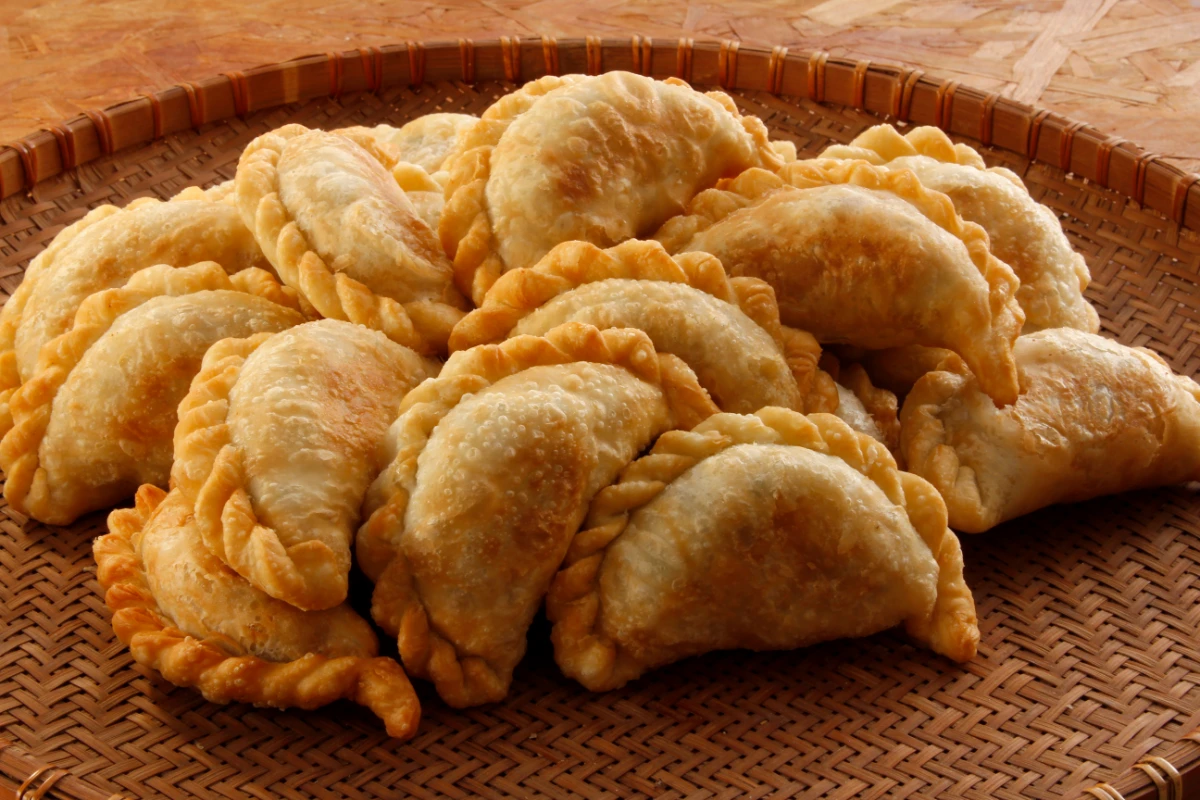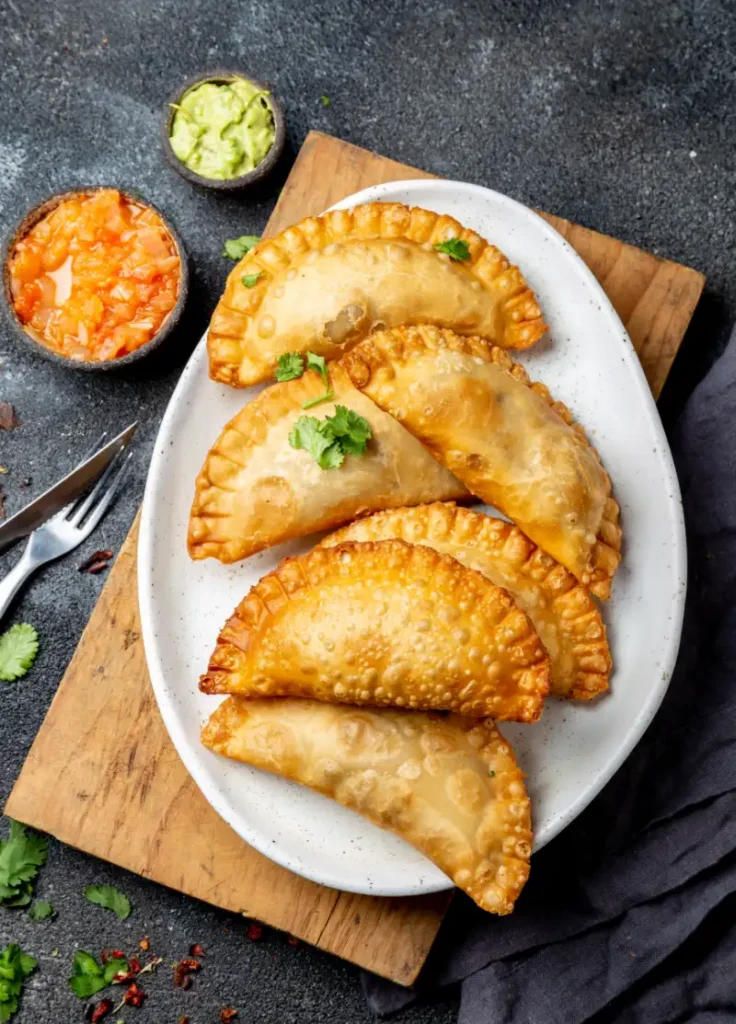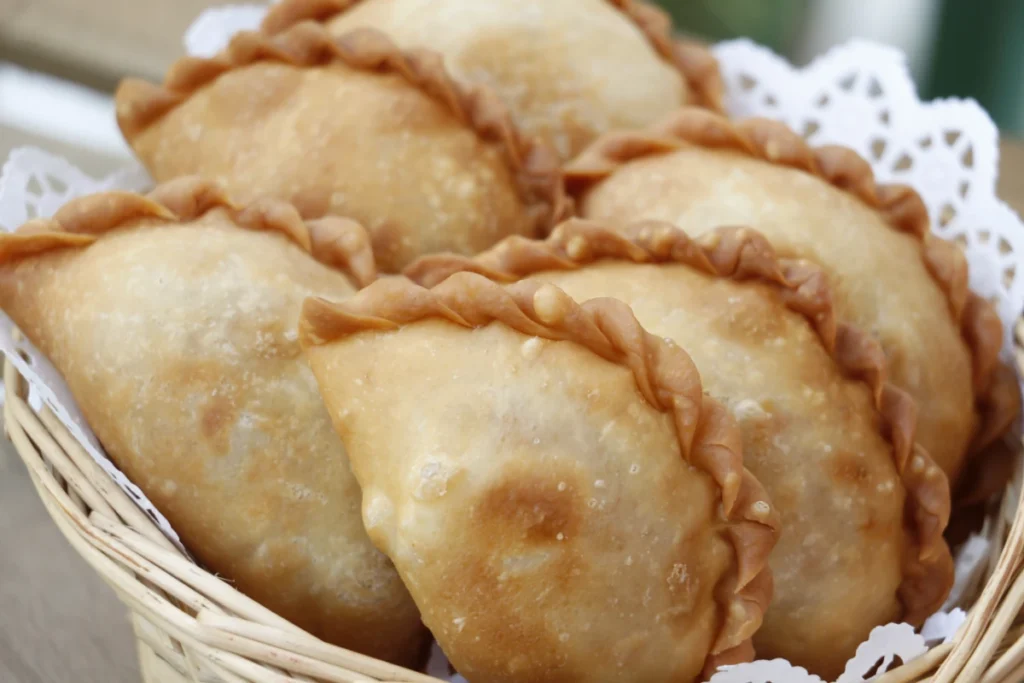Are you craving a delectable, handheld treat that’s bursting with flavor? Look no further than empanadas – the beloved pastry that has captured hearts (and taste buds) across the globe. At the heart of these savory or sweet delights lies the empanada dough, a deceptively simple yet crucial component that elevates the entire experience. Buckle up as we embark on a mouthwatering exploration of what dough are empanadas made of, uncovering the secrets behind this versatile and delicious canvas.
Introduction to Empanada Dough
What Are Empanadas?
Empanadas are essentially little pockets of dough stuffed with an array of tantalizing fillings. These handheld pastries have their roots in Spanish and Portuguese cuisine but have since spread their culinary influence far and wide. From the bustling streets of Latin America to the cozy cafes of Europe, empanadas have become a beloved snack, appetizer, or even a meal in their own right.
Empanada Dough: The Foundation of a Delicious Pastry
While the fillings undoubtedly steal the spotlight, the true star of the show is the empanada dough. This unassuming yet crucial component serves as the backbone, cradling the flavors within and providing a delightful textural contrast. Without a well-executed dough recipe, even the most mouthwatering fillings would fall flat.
Empanada doughs come in various forms, each with its unique texture and taste. From the classic, flaky pastry dough to the hearty masa dough (made from nixtamalized corn flour), the options are as diverse as the regions and cultures that have embraced these tasty morsels. Moreover, the dough acts as a versatile canvas, allowing bakers to experiment with different flavors, from savory herbs to sweet spices, further elevating the empanada experience.
In this comprehensive guide, we’ll dive deep into the world of empanada doughs, exploring traditional recipes, preparation techniques, and cooking methods. Get ready to become an empanada master, crafting the perfect dough that will have your friends and family begging for more. Trust us, once you’ve mastered the art of empanada dough, you’ll never look at these little pockets of joy the same way again.
Traditional Empanada Dough Recipes
When it comes to empanada doughs, tradition reigns supreme. These time-honored recipes have been passed down through generations, each with its own unique twist and cultural significance.
Classic Empanada Dough
At the heart of many empanada traditions lies the classic dough recipe. Simple yet sublime, this dough typically consists of just a few ingredients: flour, water, salt, and fat (usually butter, lard, or vegetable shortening). Despite its humble composition, achieving the perfect texture is an art form.
Ingredients:
- 3 cups (375g) all-purpose flour
- 1 tsp salt
- 1/2 cup (113g) unsalted butter, chilled and cubed
- 1/2 cup (95g) shortening or lard, chilled
- 3/4 cup (180ml) ice water
Directions:
- In a large bowl, whisk together the flour and salt.
- Using a pastry cutter or two forks, cut in the butter and shortening/lard until mixture resembles coarse crumbs with pea-sized pieces remaining.
- Add in the ice water a little at a time, mixing gently with a fork until the dough just begins to come together. Do not overmix.
- Turn the dough out onto a lightly floured surface and knead briefly, about 5-6 times, until it forms a smooth ball. Be careful not to overwork.
- Cover dough with plastic wrap and refrigerate for at least 30 minutes, up to overnight. This allows the gluten to relax.
- When ready to use, divide the dough in half and roll out on a lightly floured surface to 1/8-inch thickness.
- Cut into rounds using a biscuit or empanada cutter. Fill with desired fillings and fold over to seal.
- Bake or fry according to recipe instructions.
Take, for instance, the Argentine empanada dough recipe. This variation calls for a combination of butter and lard, resulting in a dough that’s both rich and flaky. Chilean empanadas, on the other hand, often feature a dough made with pork lard, lending a distinct, savory flavor.
Colombian empanadas are known for their crispy, golden shells made from a dough that incorporates both butter and eggs. This added richness perfectly complements the hearty fillings, such as shredded beef or chicken.
Masa Empanada Dough
While the classic dough reigns supreme in many regions, others have embraced a more rustic approach with masa dough. This corn-based dough is a staple in Mexican and Central American cuisines, offering a delightfully earthy and slightly sweet flavor.
To make masa dough, dried corn kernels are soaked in a calcium hydroxide solution (a process called nixtamalization), and then ground into a dough-like consistency. This traditional method not only enhances the corn’s flavor but also improves its nutritional value.
Mexican empanadas, known as empanadas de maíz, often feature this masa dough, which is then stuffed with savory fillings like chorizo, potatoes, or queso fresco. In El Salvador, the masa dough is rolled extra thin, resulting in delicate empanadas that are a true delight.
Gluten-Free Empanada Dough
With the rise of gluten-free diets, empanada enthusiasts have embraced alternative dough recipes that cater to this dietary need. One popular option is a gluten-free dough made with a blend of rice flour, tapioca starch, and xanthan gum.
While this dough may lack the stretchy, elastic quality of traditional wheat-based doughs, it more than makes up for its in flavor and texture. The key to achieving a successful gluten-free empanada dough lies in the proper ratio of ingredients and handling techniques.
No matter which dough you choose, the beauty of empanadas lies in their versatility. Each bite offers a harmonious fusion of flavors and textures, all encapsulated within a perfectly crafted dough shell.
Empanada Dough Preparation Techniques
Beyond the ingredients, the success of an empanada dough hinges on proper preparation techniques. From kneading to folding, these crucial steps can make or break your dough’s texture and overall quality.
Kneading and Resting the Dough
Kneading is an essential process that develops the gluten strands in wheat-based doughs, creating a smooth, elastic texture. However, the key is to strike the right balance – too little kneading results in a crumbly dough, while over-kneading can make it tough and chewy.
As a general rule, knead the dough for 5 to 10 minutes until it becomes smooth and elastic, using the heel of your hand to press and fold the dough repeatedly. If the dough seems dry, add a touch of water; if it’s too sticky, dust it with a little flour.
Once the dough is properly kneaded, let it rest for at least 30 minutes (or up to an hour for better gluten development). This resting period allows the gluten strands to relax, making the dough easier to roll out and less prone to shrinking during baking.
Rolling and Folding Empanada Dough
With your well-rested dough, it’s time to roll and shape those delectable empanada pockets. For the classic half-moon shape, roll the dough into a thin circle (about 1/8 inch thick) and cut it into rounds using a cookie cutter or the rim of a glass.
Place a spoonful of your desired filling in the center of each round, then fold the dough over to form a half-moon shape. Crimp the edges with a fork or your fingers to seal the empanada tightly.
No matter which folding method you choose, be sure to crimp or seal the edges well to prevent any filling from leaking out during cooking.
Handling Sticky Dough
Even for experienced bakers, sticky dough can be a frustrating obstacle. If your empanada dough seems overly sticky, try chilling it for 10-15 minutes before rolling it out. You can also dust your work surface and rolling pin with a little flour to prevent sticking.
Avoid the temptation to add too much extra flour, as this can lead to a dry, crumbly dough. Instead, work quickly and handle the dough as little as possible to prevent it from becoming overworked and tough.
With these preparation techniques under your belt, you’re well on your way to crafting empanada dough that’s a true work of art.
Cooking Empanada Dough
Once you’ve mastered the art of dough preparation, it’s time to turn your attention to the cooking process. Whether you prefer the golden crunch of a baked empanada or the irresistible crispiness of a fried one, understanding the nuances of each method is key to achieving perfection.
Baking Empanadas
For those seeking a slightly healthier alternative to frying, baking empanadas is a fantastic option. This cooking method not only reduces the overall fat content but also allows for a delightful range of flavors and textures.
When baking empanadas, preheating your oven to 400°F (200°C) is crucial. This high temperature ensures that the dough crisps up nicely on the outside while the filling remains hot and gooey on the inside.
Depending on the size of your empanadas, baking times can range from 15 to 25 minutes. Keep an eye on them and rotate the baking sheet halfway through for even browning.
One pro tip for achieving a golden, flaky crust: brush the empanadas with an egg wash (a mixture of beaten egg and water) before baking. This simple step adds a beautiful shine and creates a crisp, layered texture that’s simply divine.
Baked empanadas pair wonderfully with an array of fillings, from hearty beef and vegetable mixtures to sweet options like apple, pumpkin, or guava.
Frying Empanadas
For those seeking an indulgent, crispy treat, frying empanadas is the way to go. This traditional cooking method yields a delightfully crunchy exterior that gives way to a soft, pillowy interior – a textural contrast that’s simply irresistible.
When frying empanadas, it’s essential to use an oil with a high smoke point, such as vegetable, canola, or peanut oil. Heat the oil to 350°F (175°C) before carefully adding the empanadas to the pan or deep fryer.
Fry the empanadas for 2 to 4 minutes per batch, flipping them occasionally to ensure even browning. Once they’ve achieved a beautiful golden hue, transfer them to a paper towel-lined plate to drain excess oil.
Fried empanadas are a perfect match for savory fillings like spicy beef, chicken with olives, or spinach and feta. The crispy exterior acts as a delightful contrast to the rich, flavorful fillings.
Regardless of your cooking method, be sure to let the empanadas cool slightly before enjoying them. This not only prevents burns but also allows the fillings to set, ensuring a delicious, mess-free experience.
Variations and Fillings
While traditional empanada doughs and fillings hold a special place in our hearts, the world of empanadas is vast and ever-evolving. From creative dough variations to unexpected filling combinations, the possibilities are truly endless.
Empanada Dough Variations
For those with a sweet tooth, sweet empanada doughs are a delightful departure from the norm. These doughs often incorporate ingredients like sugar, cinnamon, or vanilla extract, creating a delicate, slightly sweetened canvas for fruit fillings or decadent chocolate concoctions.
If you’re seeking a healthier alternative, whole wheat or alternative flour doughs (like spelt, oat, or almond flour) offer a nutty, earthy twist on the classic. These doughs not only provide a nutritional boost but also bring a unique flavor and texture to the table.
And for the adventurous bakers out there, why not experiment with infusing the dough itself with herbs or spices? A hint of rosemary, for instance, can elevate a savory empanada to new heights, while a touch of cardamom can add warmth to a sweet filling.
Popular Empanada Fillings
When it comes to fillings, empanadas are a true canvas for creativity. From classic savory options to unexpected sweet surprises, the possibilities are endless.
On the savory front, shredded beef, chicken, or pork are always crowd-pleasers, often accompanied by a medley of sautéed vegetables, olives, or cheese. For a vegetarian twist, try a hearty combination of mushrooms, spinach, and feta.
In the realm of sweet empanadas, fruit fillings reign supreme. Apple, pumpkin, guava, or pineapple are all delightful options, often enhanced with a touch of cinnamon or nutmeg.
But why stop there? Chocolate-hazelnut, dulce de leche, or even sweet corn fillings can elevate your empanada game to new heights.
No matter what filling you choose, remember to balance the flavors and textures. A juicy filling pairs beautifully with a flaky dough, while a drier filling may benefit from a richer, more substantial dough.
As you explore the world of empanada variations and fillings, don’t be afraid to get creative and put your spin on these beloved pastries.
FAQs
As you embark on your empanada-making journey, you may encounter a few questions along the way. Fear not, for we’ve compiled some of the most frequently asked questions to help guide you through the process.
Can empanada dough be made in advance?
- A: Absolutely! Making the dough ahead of time can be a real time-saver. Empanada dough can be refrigerated for up to 3 days or frozen for up to 3 months. Just be sure to wrap it tightly in plastic wrap or store it in an airtight container to prevent it from drying out.
How do I store and freeze empanada dough?
- A: For short-term storage (up to 3 days), simply wrap the dough tightly in plastic wrap and refrigerate. For longer storage, divide the dough into portions, wrap each portion tightly in plastic wrap, and then place them in a resealable freezer bag or airtight container. When ready to use, thaw the frozen dough in the refrigerator overnight before rolling and filling.
Can empanada dough be reheated?
- A: Yes, you can reheat empanadas to enjoy their crispy, fresh-from-the-oven (or fryer) texture. For baked empanadas, place them on a baking sheet and reheat in a 350°F (175°C) oven for 5-10 minutes. For fried empanadas, you can briefly refry them or reheat them in the oven or air fryer at 400°F (205°C) for 5-7 minutes.
How do I prevent soggy empanadas?
- A: Soggy empanadas are often the result of excess moisture in the filling or improper sealing. To avoid this, be sure to drain any excess liquid from your fillings before stuffing the empanadas. Additionally, crimp or seal the edges tightly to prevent any leakage during cooking.
Any tips for achieving a flaky crust?
- A: A flaky crust is the hallmark of a delicious empanada. To achieve this texture, be sure to use a dough with a high-fat content (like butter or lard) and handle the dough as little as possible. Overworking the dough can cause the gluten strands to develop too much, resulting in a tough crust.
With these frequently asked questions addressed, you’re now equipped with the knowledge to tackle any empanada dough conundrum that comes your way.
Conclusion
Mastering the Art of Empanada Dough
As you’ve discovered throughout this comprehensive guide, the humble empanada dough is a true masterpiece in its own right. From the classic recipes steeped in tradition to the innovative variations that push boundaries, the possibilities are endless.
Whether you prefer a flaky pastry dough or a heartier masa base, the key lies in mastering the techniques – kneading, resting, rolling, and cooking to perfection. So go forth, experiment with different doughs and fillings, and let your culinary creativity shine through in every delectable bite.
After all, the art of empanada dough is a delicious journey worth savoring.
Additional Tasty Recipes:
- Pumpkin Empanadas: Immerse yourself in the warm, comforting embrace of our Pumpkin Empanadas, a delightful twist on a classic treat. These empanadas are stuffed with a rich, spiced pumpkin filling that perfectly encapsulates the essence of autumn. Each bite delivers a burst of cozy flavors that are sure to bring a smile to your face. Ideal for a festive gathering or a quiet autumn evening, these empanadas are a seasonal must-try.
- Red Velvet Cookies: Indulge in the irresistible charm of our Red Velvet Cookies, where classic elegance meets decadent pleasure. These cookies are not just a feast for the eyes with their striking red hue, but also a delight to the palate with their rich, chocolatey flavor and velvety texture. Topped with a luscious cream cheese frosting, they’re the perfect treat for any celebration or a sweet end to a romantic meal.
Red Velvet Cookies: A Deliciously Festive Treat for Any Occasion



